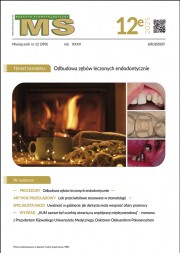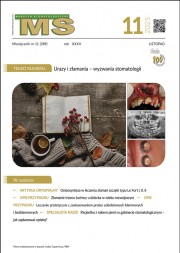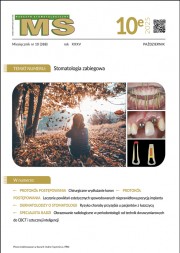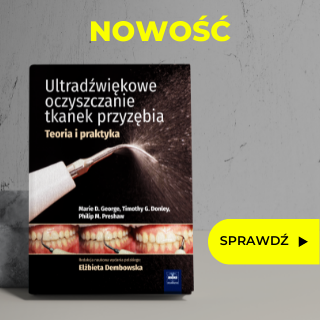Dostęp do tego artykułu jest płatny.
Zapraszamy do zakupu!
Po dokonaniu zakupu artykuł w postaci pliku PDF prześlemy bezpośrednio pod twój adres e-mail.
TEMAT NUMERU
Artykuł przeglądowy
Wybór klinicznego zastosowania łączników protetycznych do prac stałych na implantach w aspekcie ich budowy – przegląd piśmiennictwa
Agata Brykczyńska, Tomasz Stasiński, Mirona Palczewska-Komsa, Janusz Kubrak, Bartosz Dalewski, Ewa Sobolewska
Leczenie implantologiczne jest leczeniem z wyboru przy pojedynczych brakach zębowych, znajduje również uzasadnienie w przypadku odbudowy rozległych braków. Ze względu na ryzyko powikłań, takich jak np. periimplantitis, bardzo ważne jest odpowiednie dobranie odbudowy protetycznej implantu, z uwzględnieniem stanu klinicznego. W niniejszej pracy dokonano omówienia łączników implantologicznych w zależności od metody osadzenia pracy stałej oraz materiału, z którego zostały wykonane. Przegląd ten może być przydatny dla lekarzy klinicystów w wyborze właściwej metody leczenia implantologicznego.
Piśmiennictwo:
- Bruna E, Fabianelli A. Implantoprotetyka. Zalety, przeciwwskazania, rozwiązania praktyczne. Bożyk A, Michalak M (red. wyd. pol.). Wrocław: Edra Urban & Partner; 2017.
- Drago C, Peterson T. Implanty dentystyczne. Procedury laboratoryjne krok po kroku. Malara P (red. wyd. pol.). Warszawa: Wydawnictwo Lekarskie PZWL; 2014.
- Maiorana C, Poli PP, Borgonovo AE i wsp. Long-Term Retrospective Evaluation of Dental Implants Placed in Resorbed Jaws Reconstructed With Appositional Fresh-Frozen Bone Allografts. Implant Dent. 2016 Jun; 25(3):400-8.
- Bruna E, Fabianelli A. Protezy stałe z bezstopniowym uszczelnieniem brzeżnym. Postępowanie kliniczne i laboratoryjne. Dawyniak-Nowak MP, Nowak M (red. wyd. pol.). Wrocław: Edra Urban & Partner; 2018.
- Attia S, Aykanat T, Chuchmová V, Stolte KN, Harder B, Schilling L, Streckbein P, Howaldt HP, Riad A, Böttger S. The influence of platform switching and platform matching on marginal bone loss in immediately inserted dental implants: a retrospective clinical study. Int J Implant Dent. 2025 Mar 4; 11(1):16.
- Sarahneh O, Günal-Abduljalil B. The effect of silane and universal adhesives on the micro-shear bond strength of current resin-matrix ceramics. J Adv Prosthodont. 2021 Oct; 13(5):292-303.
- Osman RB, Swain MV. A Critical Review of Dental Implant Materials with an Emphasis on Titanium versus Zirconia. Materials (Basel). 2015 Mar 5; 8(3):932-958.
- Linkevičius T. Zero bone loss. Koncepcje implantologiczne. Ostrowska-Suliborska B (red. wyd. pol.). Warszawa: Wydawnictwo Kwintesencja; 2019.
- Kinsel RP, Lin D. Retrospective analysis of porcelain failure of metal ceramic crowns and fixed partial dentures supported by 729 implants in 152 patients: Patient-specific and implant-specific predictors of ceramic failure. J Prosthet Dent. 2009; 101(6): 388-394.
- Lang NP. Periimplant diseases: Where are we now? – Consensus of the Seventh European Workshop on Periodontology. J Clin Periodontol. 2011; 38(11): 178-181
- Froum SJ (red.). Powikłania w implantologii stomatologicznej. Etiologia, zapobieganie i leczenie. Lewkowicz N (red. wyd. pol.). Lublin: Czelej; 2019. Kinsel RP, Lin D.
- Bartlett Implants for life? A critical review of implant-supported restorations. J Dent. 2007 Oct;35(10):768-72.
- Dornbush JR, Reiser GM, Ho DK. Platform switching and abutment emergence profile modification on peri-implant soft tissue. Alpha Omegan. 2014 Summer; 107(2):28-32.
- den Hartog L, Raghoebar GM, Stellingsma K, Vissink A, Meijer HJ. Immediate Loading of Anterior Single-Tooth Implants Placed in Healed Sites: Five-Year Results of a Randomized Clinical Trial. Int J Prosthodont. 2016 Nov/Dec; 29(6):584-591.
- Jemt T. Regeneration of gingival papillae after single-implant treatment. Int J Priodontics Restorative Dent. 1997; 17(4): 326-333.
- Zhai Z, Nakano T, Chen Y i wsp. Implant deformation and implant-abutment fracture resistance after standardized artificial aging: An in vitro study. Clin Implant Dent Relat Res. 2023 Feb; 25(1):107-117.
- Ragupathi M, Mahadevan V, Azhagarasan NS i wsp. Comparative evaluation of the wear resistance of two different implant abutment materials after cyclic loading - An in vitro study. Contemp Clin Dent. 2020 Jul-Sep; 11(3):229-236.
- Dixon DL, Breeding LC, Sadler JP, McKay ML. Comparison of screw loosening, rotation, and deflection among three implant designs. J Prosthet Dent. 1995 Sep; 74(3):270-8.
- Borgonovo AE, Ferrario S, Maiorana C i wsp. A Clinical and Radiographic Evaluation of Zirconia Dental Implants: 10-Year Follow-Up. Int J Dent. 2021 Dec 30; 2021:7534607.














